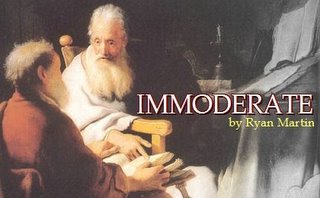Lints has it right (I think)
The fourth chapter of Richard Lints' The Fabric of Theology* addresses the “trajectory of theology,” or the development of revelation and, ultimately, theology through time. He begins by addressing the culture, the influence of culture on our understanding of revelation, and how to move forward communicating God’s revelation ourselves in the midst of culture. The Christian faith is passed on to generation after generation, and with each new generation the faith must be defended against the errors that are levied against it by that generation’s non-Christian culture. Unfortunately, this has become somewhat difficult in light of the abandonment of tradition by both “antitraditionalism” (liberalism) and “antitraditional traditionalism” (American evangelicalism).
In discussing the “antitraditional traditionalism” of evangelicalism, Lints has one of his most illuminating passages in the book (91-96). He notes that evangelicalism has developed to their current state because of the emphasis on 1) inductive interpretation of the Bible divorced from any coherent tradition, 2) the parachurch identity which minimized theological and denominational distinctives, and 3) an ahistorical piety, uniformed by the Christian past. Concerning the trend of the "private Bible" in contemporary evangelicalism, he writes, "The Bible becomes captive to the whims of the individual freed from external constraints, and in such a situation the individual can imagine the text to say whatever he or she wants it to say" (93). The effect of the "parachurch church" culture in evangelicalism is one of theological reduction in its organization around evangelical "essentials," and even its defense of those essentials. This parachurch trend inevitably results in much of evangelicalism severing itself from theological traditions. In other words, in attempting to articulate that evangelicalism has a core, the tendency is to diminish the importance of other doctrine. Finally, Lints criticizes the effects of "temporal piety" in evangelicalism, lamenting, "The classics of evangelical devotional literature stretch back no further than 1952 [!] with the publication of C. S. Lewis' Mere Christianity. . . . They have convinced themselves that every important thing has happened in the present century and every important book (excepting the Bible, of course) has been written in their own lifetime" (95-96).
Noting the present cultural state, he convincingly demonstrates that culture does serve as a lens that can often distort theology. Yet, Lints says, “The theologian’s hope lies not in an ability to remove our cultural blinders so that we might see God but in the power of God to break through our cultural blinders and thereby enable us to see ourselves more clearly by the radiance of his glory” (106). Lints believes that cultures can “communicate beyond their barriers” (104), and that God himself communicates across cultural frameworks. Yet the theologian should be aware of his cultural predilections, particularly as he moves from exegesis to doctrine. A similar truth holds for the evangelical perspective of the use of reason. A both native and cultural rationale exist in man, and we should appeal as much as we can to this reason, complex as it may be, with our theology and articulations of the gospel. “We must seek to ensure,” Lints concludes, “that cultural expressions in the theological framework always remain open to correction by the Scriptures themselves. The framework of the Scriptures must take precedence over the cultural expressions of that framework” (135).
*Lints, Richard. The Fabric of Theology: A Prolegomenon to Evangelical Theology. Grand Rapids: Eerdmans, 1993.
In discussing the “antitraditional traditionalism” of evangelicalism, Lints has one of his most illuminating passages in the book (91-96). He notes that evangelicalism has developed to their current state because of the emphasis on 1) inductive interpretation of the Bible divorced from any coherent tradition, 2) the parachurch identity which minimized theological and denominational distinctives, and 3) an ahistorical piety, uniformed by the Christian past. Concerning the trend of the "private Bible" in contemporary evangelicalism, he writes, "The Bible becomes captive to the whims of the individual freed from external constraints, and in such a situation the individual can imagine the text to say whatever he or she wants it to say" (93). The effect of the "parachurch church" culture in evangelicalism is one of theological reduction in its organization around evangelical "essentials," and even its defense of those essentials. This parachurch trend inevitably results in much of evangelicalism severing itself from theological traditions. In other words, in attempting to articulate that evangelicalism has a core, the tendency is to diminish the importance of other doctrine. Finally, Lints criticizes the effects of "temporal piety" in evangelicalism, lamenting, "The classics of evangelical devotional literature stretch back no further than 1952 [!] with the publication of C. S. Lewis' Mere Christianity. . . . They have convinced themselves that every important thing has happened in the present century and every important book (excepting the Bible, of course) has been written in their own lifetime" (95-96).
Noting the present cultural state, he convincingly demonstrates that culture does serve as a lens that can often distort theology. Yet, Lints says, “The theologian’s hope lies not in an ability to remove our cultural blinders so that we might see God but in the power of God to break through our cultural blinders and thereby enable us to see ourselves more clearly by the radiance of his glory” (106). Lints believes that cultures can “communicate beyond their barriers” (104), and that God himself communicates across cultural frameworks. Yet the theologian should be aware of his cultural predilections, particularly as he moves from exegesis to doctrine. A similar truth holds for the evangelical perspective of the use of reason. A both native and cultural rationale exist in man, and we should appeal as much as we can to this reason, complex as it may be, with our theology and articulations of the gospel. “We must seek to ensure,” Lints concludes, “that cultural expressions in the theological framework always remain open to correction by the Scriptures themselves. The framework of the Scriptures must take precedence over the cultural expressions of that framework” (135).
*Lints, Richard. The Fabric of Theology: A Prolegomenon to Evangelical Theology. Grand Rapids: Eerdmans, 1993.





0 Comments:
Post a Comment
<< Home